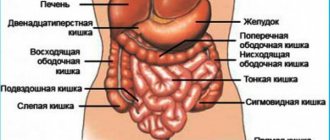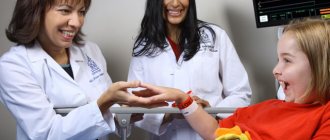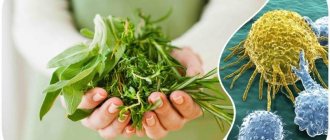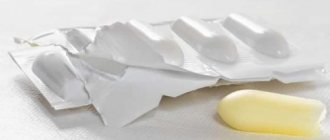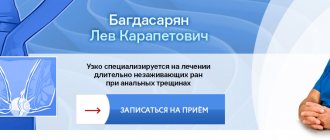Home » Hemorrhoids » Thrombosis of hemorrhoids
Sign up for a consultation with a proctologist for the treatment of hemorrhoids for 3,500 rubles and receive a treatment prescription within 30 minutes for 1 appointment
Find out what day you need to make an appointment to get a consultation without a queue.
Experience 44 years 73 operations per month 876 operations per year 171 reviews Author of 73 scientific papers Has 9 patents 6,818 requests per month
Call
Thrombosis of hemorrhoids is a complicated stage of chronic hemorrhoids. The disease develops due to impaired bleeding. Blood clots form in the structure of the cavernous vascular plexuses. The acute process lasts for a week. After this, the thrombosed node is replaced by connective tissue. In the absence of timely treatment, necrosis of ulcerative formations on the intestinal mucosa develops.
As a result, complications arise: a blood clot that formed earlier blocks the vascular lumen and prevents the reverse flow of blood from the nodular protrusion. This is why blood clots occur.
Depending on the location, the following types of hemorrhoidal thrombosis are distinguished:
- interior;
- outer;
- combined;
Proctological pathology is classified into three degrees of severity, which have different etiologies, symptoms and neglect.
Briefly about the main thing
Thrombectomy is a minimally invasive (low-traumatic) operation that is performed to eliminate a blood clot formed in hemorrhoids.
This intervention is performed for acute hemorrhoids. Thrombectomy is performed under local anesthesia and takes no more than 10 minutes . The procedure has the shortest list of contraindications and does not require hospitalization of the patient. You can go home immediately after surgery .
The recovery period passes quickly and is not associated with serious restrictions. It will be necessary to follow basic hygiene rules: wash the anal area with warm water after each bowel movement. You should also follow all the doctor’s recommendations: ___• follow a diet, ___• limit physical and nervous stress, ___• avoid excluding thermal procedures, ___• take prescribed medications, ___• carry out local treatment of the postoperative wound.
Causes of thrombosis of hemorrhoidal veins
Thrombosis can develop as a consequence of an acute, first-time attack of hemorrhoids, as well as as a complication of chronic hemorrhoids. The likelihood of developing thrombosis in chronic pathology increases with increasing “length” of the disease and the size of the nodes.
An attack can be triggered by: ___• chronic stool disorders (constipation, diarrhea, constipation alternating with diarrhea), ___• increased physical activity, ___• labor, ___• consumption of spicy food and/or alcohol, ___• hypothermia, overheating.
The development of acute hemorrhoids is promoted by all conditions accompanied by an increase in intra-abdominal pressure - from pregnancy to chronic cough and obesity.
Another factor in the occurrence of hemorrhoids is stagnation of blood in the veins of the pelvis, which often occurs as a result of a sedentary lifestyle and “sedentary” work.
Mechanism of blood clot formation
Thrombosis of external hemorrhoids occurs more often. It is extremely rare that the process spreads from external to internal nodes. Even less commonly, it occurs isolated in internal nodes.
Thrombosis of the external hemorrhoid occurs in both acute and chronic processes. In both cases, the pathology develops as a result of a combination of three factors: ___• slowing blood flow in the node, ___• blood thickening, ___• damage to the vascular network of the hemorrhoid.
Signs of thrombosis
___• The main symptom of thrombosis is acute, excruciating pain that prevents normal bowel movements. The pain syndrome intensifies many times over with straining, movement, and also in a sitting position. In severe cases, the pain takes on a pulsating character and, depending on the location of the node, can radiate to the leg, inside the rectum or to the external genitalia. ___• Bleeding often occurs, which varies in intensity - from individual drops on the surface of the stool to a trickle of blood during bowel movements. ___• Thrombosis of the internal node causes the sensation of a foreign body inside the rectum. Since the bleeding injured node comes into contact with feces, a secondary infection may occur. In such cases, mucous or purulent discharge appears and body temperature rises.
Hemorrhoidal thrombosis - symptoms and treatment
Acute hemorrhoids is a disease, with adequate treatment of which, in 98 - 100% of cases, complete relief from the manifestations of thrombophlebitis is possible.* With conservative management of an exacerbation after the signs of inflammation subside, the disappearance of edema, further treatment of hemorrhoidal disease is indicated using numerous methods (minimally invasive: latex ligation, sclerotherapy, laser vaporization or classic hemorrhoidectomy). Correcting changes in chronic hemorrhoidal disease is necessary, among other things, to exclude relapses of thrombophlebitis of the nodes and improve the quality of life.
The choice of method for removing pathologically altered cavernous plexuses in chronic headache depends on their location, size, degree of dystrophic changes in the underlying tissues (stage of the disease), the availability of modern medical equipment in the medical institution and the surgeon’s preferences.
Prevention of the disease consists of eliminating factors that provoke exacerbation of hemorrhoidal disease:
- Normalization of stool;
- Drinking enough fluids throughout the day;
- Increasing physical activity**, combating physical inactivity;
- Nutrition correction - increasing the diet of plant fiber, vegetables and fruits, fermented milk products***;
- Limiting the intake of strong alcohol and spicy foods;
- Treatment of chronic inflammatory processes in the perianal area (proctosigmoiditis, chronic hemorrhoids);
- Reducing body weight to optimal parameters (BMI 20-23);
- Treatment of concomitant diseases - arterial hypertension, diseases of the gastrointestinal tract.
*if in complex therapy surgical aids with coagulation of the vessels feeding the node were used.
**dosed physical activity helps normalize weight, metabolism, and strengthen the pelvic floor muscles. However, they should exclude activities that lead to a sharp increase in intra-abdominal pressure (deadlifts, squats with loads, weightlifting, powerlifting).
***if diet correction is not enough, for persistent constipation, regular use of probiotics and prebiotics, laxatives - lactulose (Lactusan, Duphalac), oval plantain seeds (Mucofalka, Fitomucila) is appropriate. Typically, the side effects of lactulose - bloating, flatulence - are eliminated by reducing carbohydrate intake, which prevents excessive growth of intestinal microflora.
Prevention of acute hemorrhoids in pregnant women
Even at the stage of pregnancy planning, girls need to consult a proctologist, because in the presence of hemorrhoidal disease, stage 1. manifestations may be minimal and unnoticeable to a young woman. However, when carrying a child, all minor problems can become quite painful for the expectant mother, and their effective treatment during pregnancy will be extremely difficult.
Repeated examination of pregnant women is indicated in the 2nd–3rd trimester. Even before the onset of birth, some pregnant women experienced some degree of exacerbation of hypertension, which is associated with impaired venous outflow from the pelvis, an increase in intra-abdominal pressure and changes in blood coagulation parameters. And during natural childbirth, thrombophlebitis occurs in almost half of women in labor due to direct compression of the nodes by the fetal head passing through the birth canal.[13]
For natural delivery, the diagnosis of hemorrhoids is not a contraindication, but the condition requires dynamic monitoring by a specialist and the implementation of certain recommendations.
When is thrombectomy necessary?
Indications for surgery
Most cases of acute thrombosis of hemorrhoids (uncomplicated thrombosis, small size of the node) respond well to treatment with conservative methods. The main thing is to consult a doctor in a timely manner.
Surgical procedures are performed if the period from the onset of the disease is 48-72 hours. If more time has passed since the onset of thrombosis, the doctor prescribes conservative treatment followed by surgical treatment. Surgical removal of a thrombosed node is carried out at a later stage from the onset of the disease in the following cases : ___• conservative therapy was unsuccessful, ___• acute pain syndrome, poorly controlled by standard painkillers, ___• symptoms of intoxication (general weakness, fever, headache), ___ • contraindications to the use of thrombolytic agents (pregnancy, lactation), ___• large size of the hemorrhoid.
The decision on surgical intervention is made by the doctor after an examination, which will reveal contraindications to surgery. Another goal of diagnostic manipulations is the choice of surgical intervention method.
Why is thrombosis dangerous?
Firstly, thrombosis never resolves on its own. The longer you delay treatment, the worse the pain.
Secondly, over time, tissue necrosis can occur when thrombosed nodes fall off and ulcers form in their place. The ulcers gradually increase in size, and purulent paraproctitis develops, the treatment of which may require serious surgery.
Don’t delay in contacting a proctologist! In most cases, hemorrhoidal thrombosis can be cured in 1 visit to the doctor.
Types of operations
Removal of a blood clot for external hemorrhoids
Removing a blood clot for external hemorrhoids is a simple operation that lasts only a few minutes. The doctor makes a small incision over the blood clot. Then the blood clot is removed with tweezers or a clamp; the wound is not sutured. The inflammatory edema subsides almost immediately, the pain subsides, and the patient’s general condition improves.
According to indications, a more complex operation can be performed - excision of an external hemorrhoid with blood clots , which is also performed under local anesthesia and does not require the patient to be hospitalized. During excision, the pathological element is removed, which reduces the risk of recurrent thrombosis.
Removal of a blood clot for internal hemorrhoids
Thrombosis of internal hemorrhoids is much less common and, as a rule, develops in the later stages of the development of the process (III-IV stages of hemorrhoids).
Treatment in this case is conservative. After stopping the acute process, treatment is carried out aimed at removing internal hemorrhoids (hemorrhoidectomy).
Diagnostics
Diagnosis of hemorrhoidal thrombosis is not difficult. The diagnosis is made by external examination of the anal area .
If the proctologist decides on surgical intervention, it will be necessary to take tests : ___• general blood test, ___• coagulogram, ___• blood glucose level.
It is necessary to tell the attending surgeon about all medications taken, since some medications (oral contraceptives, non-steroidal anti-inflammatory drugs, etc.) affect blood clotting.
Symptoms
Determining the external type of the disease is difficult because the symptoms are smooth, but the symptoms of thrombosis with the internal location of the hemorrhoid are pronounced. These manifestations can be defined as follows:
- Feeling of burning and itching in the anus. Discharge is possible, especially after defecation (from straining).
- The presence of blood in the stool - at first scanty, then abundant.
- The occurrence of an attack of acute pain in the anus (not associated with the process of emptying).
- Prolapse of hemorrhoidal cones that cannot be reduced.
- Swelling of the skin near the anus, gradually spreading to the groin area and accompanied by severe pain.
- Painful sensations not only when making movements, but also at rest.
Symptoms intensify as the disease progresses. Normal touching of the skin becomes unbearable as the inflammatory process spreads. Thrombosis of the hemorrhoidal node is visible externally (when examined by a specialist). The hemorrhoid often becomes purple in color, and necrotic areas of the skin are noted. If enhanced measures are not taken to treat the patient at this stage, a rupture of a thrombosed hemorrhoid with heavy bleeding or purulent paraproctitis may occur.
Contraindications
___• The operation is not performed if the patient’s condition is extremely serious (general exhaustion, complications of cardiovascular diseases, sepsis). ___• Surgical interventions are not prescribed for severe pregnancy (severe anemia, poorly controlled early toxicosis with dehydration, late toxicosis with generalized edema, etc.).
Since thrombectomy is a minimally invasive (low-traumatic) operation, the procedure can be prescribed after the patient’s condition has been stabilized. The decision about surgery or its inadmissibility is made individually, taking into account all risk factors.
Preparation for the procedure
If the doctor decides to undergo thrombectomy, the patient is prescribed a diet that excludes foods that cause gas formation in the large intestine (cabbage, legumes, fresh fruits and juices from them). The ban also includes products that cause a rush of blood to the rectum and/or have an irritating effect on the mucous membrane (smoked meats, spicy foods, alcohol).
Immediately before the procedure (in the morning and evening before the operation), you will need to cleanse the intestines using a Microlax microenema.
Preparation for thrombectomy is carried out when the patient's condition allows it. In case of severe pain and an impressive size of the node, bowel cleansing is not performed, and in the event of a threat of severe complications, surgical removal of the blood clot is carried out on an emergency basis.
Diagnosis of thrombosis
The examination is carried out in the most comfortable position for the patient!
A comprehensive diagnosis is carried out for a more complete and in-depth study, allowing you to see the full clinical picture of the disease:
- Digital examination of the rectum
- Hardware diagnostics Videoanoscopy
- Video sigmoidoscopy
Depending on the clinical symptoms and complaints (for example, a complaint that the anus is itchy), the proctologist may prescribe additional examination methods.
How is the operation performed?
The procedure can be performed in a gynecological-style chair or on a couch and takes a few minutes. First, doctors give an anesthetic injection that “freezes” the tissue, just like in a dentist’s office. Therefore, the patient is conscious, but does not feel pain.
The surgical intervention takes several minutes and involves three manipulations: ___• opening the affected node (small incision), ___• removing the blood clot, ___• stopping the bleeding (the wound can be sutured, but more often it is not sutured)
After the procedure you can go home.
The exception is those cases of thrombosis when severe complications occur (gangrene of the node, paraproctitis, severe bleeding) that require hospitalization.
Carrying out the operation
Thrombectomy is an operation during which a blood clot is removed from the affected vessel. During surgery, the patient is positioned on a couch or chair that resembles a gynecological one. He is given an anesthetic injection - the patient loses sensitivity in the operated area, but remains conscious. Then proceed to the operation itself, which can be carried out using 2 methods:
- Traditional.
- Endovascular.
With traditional thrombectomy, the clot is removed along with the affected area of the vessel. This method is used in severe cases.
Endovascular thrombectomy is much more often used. This is a more gentle operation, during which a small incision (about 3 mm) is made at the site of the blockage, a catheter is inserted into it, through which the clot is removed. The incision is then sutured and the surgical area is covered with a bandage. The procedure lasts about 15 minutes.
The method of performing the operation is chosen by the doctor taking into account:
- Thrombus location.
- Patient's age.
- Conditions of blood vessels.
- Causes of thrombus development.
Rules of behavior in the postoperative period
If the evacuation of hemorrhoidal blood clots was carried out against the background of the patient’s satisfactory condition, then the postoperative period does not provide for significant restrictions.
The following are prohibited: ___• physical activity, ___• thermal procedures (bath, sauna, beach holiday), ___• prolonged stay in a sitting or squatting position.
Products that cause a rush of blood to the pelvic vessels or irritation of the mucous membrane are excluded from the diet: spicy, salty, smoked foods and alcohol.
Food should be rich in fiber, which stimulates intestinal function (prunes, apples). It is not recommended to eat foods that can cause constipation (rice and semolina porridge, potatoes, pasta). If stool retention occurs, a mild laxative (for example, Forlax) is prescribed.
After each bowel movement, wash the anal area with warm water and change the sterile napkin. If suspicious symptoms appear (pain, bleeding, discharge from the wound), you should immediately consult a doctor.
Possible complications
If you follow your doctor's recommendations, complications after thrombectomy of hemorrhoids practically do not occur. The only thing that may bother the patient is increased pain in the perianal area. It can be eliminated using any medications approved for use by a doctor.
If hygiene standards are not observed, the postoperative wound may become infected. If swelling, redness of the suture appears, or an increase in body temperature, it is recommended to consult a proctologist.
Reviews from patients and recommendations from doctors
We analyzed online reviews of patients who underwent removal of hemorrhoidal thrombosis. The vast majority of patients were satisfied with the procedure. The most common impression: “The procedure itself is not as unpleasant as waiting for it.”
No reviews of complications of the operation were found. The most common complaint is pain in the area of the postoperative suture, which disappears after a few hours, but may reappear during bowel movements.
A more serious drawback is the likelihood of relapse. In order to avoid recurrent thrombosis, you must follow all the recommendations of your doctor.
Pros and cons of the operation
The undeniable advantages of thrombectomy include:
- Speed – the operation takes no more than 15 minutes.
- Elimination of pain syndrome.
- Low level of trauma.
- Restoring normal blood circulation in the previously affected area.
- Short rehabilitation period - the patient can return to their normal lifestyle in about 2 days.
The disadvantage of the operation is the possibility of relapses.
Attention! Thrombectomy eliminates the blood clot, but does not relieve the patient of hemorrhoids. To avoid the development of further complications, this disease should be treated.
Advantages and disadvantages of the method
Thrombectomy is a low-traumatic method of treating acute thrombosis of hemorrhoids, which has both advantages and disadvantages. The method involves surgical intervention, so it is prescribed if conservative methods are contraindicated or ineffective.
Positive aspects of thrombectomy: ___• a short list of contraindications, ___• does not require hospitalization, ___• the shortest recovery period with a minimum number of restrictions, ___• minor side effects of the operation (pain, weakness, swelling), ___• complications are extremely rare.
Disadvantages of the method. Thrombectomy does not involve removal of the hemorrhoid, so recurrent thrombosis may develop. For this reason, in case of recurrent thrombosis, a more radical operation to remove thrombosed nodes (hemorrhoidectomy) is indicated.
Prevention of relapse
Basic principles of prevention
Thrombosis of the hemorrhoidal node occurs as a complication of hemorrhoids, therefore, prevention of relapse consists in preventing the occurrence of enlarged hemorrhoids.
Hemorrhoids are a disease with a hereditary predisposition. Therefore, if there has already been one attack, there is a high probability of relapse. However, the implementation of a negative scenario is possible in the presence of additional risk factors: ___• pregnancy, ___• taking hormonal drugs, ___• overweight, ___• constant diet violations: eating spicy and fatty foods, alcohol, ___• abuse of thermal procedures (bath and sauna) or regular hypothermia, ___• work involving prolonged sitting or heavy physical work.
Necessary precautions
Most often, acute thrombosis occurs as a consequence of prolonged bowel dysfunction (chronic constipation). Therefore, you need to achieve daily bowel movements with a diet rich in fiber.
It is advisable to refrain from physical and nervous overload, as well as from hypothermia and overheating of the lower half of the body. You should not abuse alcohol, as well as spicy, smoked and salty foods.
When working “sedentarily”, you need to take regular breaks, during which you should perform hemorrhoid-preventing exercises. Many chronic diseases can contribute to the development of hemorrhoids, so taking care of your health is a reliable prevention of thrombosis of hemorrhoids.
Dangerous for the development of hemorrhoids and obesity. With this pathology, intra-abdominal pressure increases, the rheological properties of the blood change, problems with stool arise, and hormonal levels are disrupted. Therefore, normal weight is not only beauty, but also health.
Detection methods
Thrombosis can be determined by a medical specialist through diagnosis, but the patient himself must be attentive to his health (especially for the external type of the disease).
Diagnostic methods:
- visual examination (on your own, with the help of loved ones or with the participation of a doctor);
- digital examination of the rectum (done by a specialist);
- use of modern equipment (anoscope, rectoscope, etc.).
Externally, the nodes look like violet-bluish formations, and when pressed on, their volume may decrease. There may be black inclusions – necrotic areas.
After palpation, it is possible to see traces of blood on medical gloves; formations inside the rectum bleed; upon contact with them, the patient complains of severe pain.
Examination of the rectum and anus using special devices can give the most complete picture of the disease and make a diagnosis of thrombosis.
Is it possible to do without surgery?
If doctors recommended thrombectomy of the hemorrhoid, this means that conservative therapy is not indicated in your case. You should not try to treat thrombosis with “traditional” methods.
If treatment is inadequate or absent, complications may develop: ___• bleeding, ___• gangrene of the node, ___• paraproctitis (purulent melting of peri-rectal fatty tissue).
In some cases, the affected node may open on its own and free itself from the blood clot. At the site of the “bump,” a fold of skin is formed – an anal fringe, which causes unpleasant sensations (itching, weeping) and is an unpleasant cosmetic defect.
Varieties
Depending on the location of the lump, we can talk about the appearance of internal, external, or combined thrombosis.
The presence of thrombosis inside is characterized by inflammation of the hemorrhoidal node (one or more), and there are frequent cases of thrombosed hemorrhoidal node falling out, which sometimes complicates examination and treatment.
The appearance of an external complication is associated with external nodes; this process often takes place with virtually no pain, with the exception of unpleasant moments associated with swelling near the anus.
Thrombosis of the combined type is not so common, because cases of inflammation of the hemorrhoid both externally and internally are rare.
